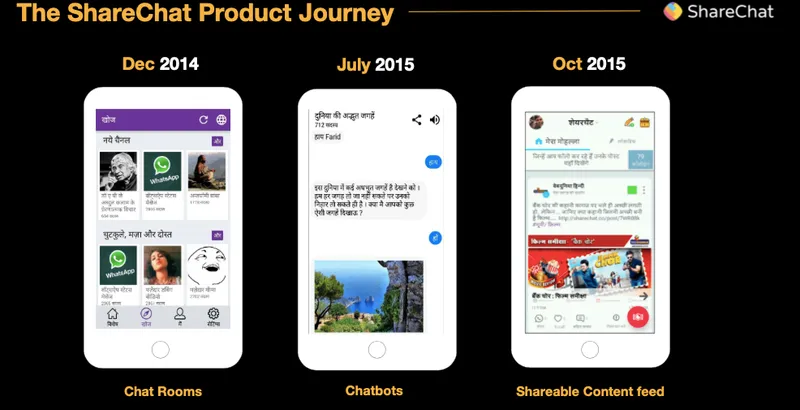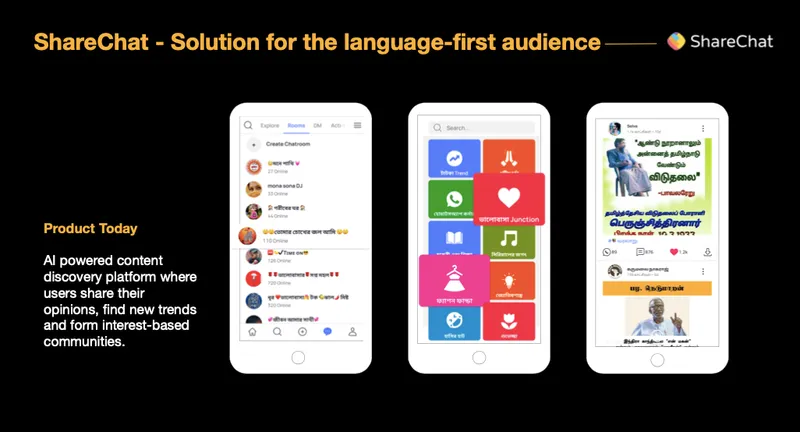[Product roadmap] The role tech played in the journey of Bharat-focused social media startup ShareChat
In this week’s Product Roadmap we feature ShareChat, one of India’s newest unicorns. Here’s the story of how technology helped the Bharat-focused social media content platform build a 280-million user community along with video platform Moj.
Ankush Sachdeva, Farid Ahsan, and Bhanu Pratap Singh had one goal: to build a strong product and tech company out of India.
The IIT Kanpur grads had participated in hackathons, built different kinds of products and tech offerings during their college years, and were sure that they wanted to build a strong and stable business.

Founders of ShareChat
When they graduated in 2014, the trio were considering building a debating platform. However, they soon realised that debates didn’t have mass appeal.
“We had met Madhukar of India Quotient in 2014 and he had suggested looking at ideas that would possibly touch new internet users. The internet was then restricted to metro cities. Most were still using WhatsApp,” Bhanu, ShareChat, CTO, says.
This led them to found Mohalla Tech, ShareChat’s parent company, in 2015. In six years, the valuation of Made-in-India social media platform ShareChat is valued at $2.1 billion. The company also launched a short video platform, Moj, in July 2020, shortly after ByteDance's TikTok app was banned in India.
Today, Moj and ShareChat have built a 280-million user community and envision building a cohesive AI-powered content ecosystem to address India’s growing digital needs.
What’s on WhatsApp?
But reaching this point wasn’t easy. It involved a whole lot of research, on-ground work, and ideation.
The co-founders decided to dig deeper to uncover problems that were yet to be addressed. They focused on how people communicated and interacted on WhatsApp groups.
“We realised many people would post their number all over the internet to get invited to different WhatsApp groups. Users in metros were careful about their numbers and joining random WhatsApp groups; new internet users wanted to consume and browse the internet,” Bhanu says.
The intent was one: sharing content. On-ground research showed that the content being shared was purely regional, and most wasn’t indexed by Google.
WhatsApp groups were a hotspot for sharing regional content, and this content found its way to Google and the web much later. But the trio realised that WhatsApp wasn't built for content consumption.
“We had the idea of giving regional content in an easy-to-share feed format and this led to the birth of ShareChat. In the initial product, people would pick a language of their choice, and we would recommend regional content in that language,” Bhanu recalls .
But it was 2015, and internet and data connectivity were not like they are today. The 2G and 3G networks didn’t give the range people needed, and a significant portion of the internet consumption happened on the desktop, unlike today.
“So we built a lightweight messaging architecture, a bi-directional connection that let one send messages. We used that architecture to build a feed product so that even people with bad network connectivity could access content. This was a game-changer. It helped us grow fast in areas of low internet connectivity,” Bhanu says.
To ensure stickiness, they enabled a WhatsApp sharing mechanism. When content from the feed was shared on WhatsApp, it would go with a watermark that said ‘content is shared by ShareChat’. This created brand recall and organic installs.

ShareChat initial products
The feed algorithm
Bhanu says the team focused on building the feed algorithm in a way that maximised outward WhatsApp sharing.
“The goal of the algorithm was to recommend content, which users could share outside. During the initial phase of any social network, the focus should be on growth. We knew early that our main focus areas would be the feed algorithm.”
The next focus areas were accessibility, availability, and speed. The idea was to architect the systems in a way that whenever the codebase got larger, it could be divided into a micro-services architecture with the right data structures and algorithms.
The metrics at ShareChat may not just be growth now, but the focus nevertheless remains on the feed algorithm. The company has several other products now and the feed algorithm has become a little more advanced and complex. The focus on the feed algorithm and speed helped ShareChat reach over 60 million users within its first year of inception.
A different user base
Speaking of their learnings from the journey that helped them build ShareChat for scale, Bhanu says, “One of the biggest learnings we have had is that if you are building a tech product for Bharat, it needs to be able to work under the conditions that the consumer is used to. The UX and text has to connect with the psyche of the user. Many English words aren’t easily understood. So all text has to be in a regional language.”
To understand this psyche, the trio travelled to different Tier II, III, and IV cities in India to get a sense of how the people there think, behave and interact.
Bhanu says they found three things: a strong gaming culture, people connecting with family and friends with WhatsApp, and the fact that a large segment was looking to access and understand the internet in regional languages.
“That was a hurdle for them as content on the internet in 2015 was only in English. We realised that while people in metro cities preferred a minimalistic look and design, Bharat users need colours, and like and share buttons that were verbose. A minimal app wouldn’t work with most Bharat users,” Bhanu says.
Gaurav Mishra, Senior Vice President of Product, ShareChat and Moj, agrees, adding that the minute you make consumption easier for users in Bharat, they “stop being passive users of the internet”.
The team also realised that there also was an underlying bias against non-English-speaking users, which changed as ShareChat has no English option. The idea was clear: a regional language focus.
“When I discussed it with Ankush he explained that if English was given as an option, many would end up selecting it even if they were not comfortable with the language,” Gaurav adds.

Current product, ShareChat
Multiple uses
Within a year, the team had realised the platform had to scale further. Since ShareChat is a feed product, there needed to be an algorithm that could easily match content to the user, while building some constraints.
“People would want to make profiles, share content, comment, and talk to other users. These were the feature sets that needed to scale. It is easy to build this for a small scale but for a large scale it was vital to figure out different solutions and permutations so that nothing crashes,” Bhanu explains.
Focusing on basic computer science principles like distributing the systems and code, and figuring data structures for use cases and separate concerns helped. For example, feed algorithms sit differently, while profiles and creation tools sit differently.
“We realised that the way you structure your engineering team holds the key to scale. So, we focused on distribution of responsibility to our product goals,” Bhanu says.
A complex problem
On what made scale easier, Debdoot Mukherjee, Vice President, AI, ShareChat and Moj, says, “Growing organically on the back of WhatsApp helped. As we started growing, we saw users finding other uses on the platform. From sharing, they started spending time on the platform for entertainment content such as music, short videos etc. The time spent soon became a key metric.”
He reveals that another unique aspect about their audience is that “they consume news differently” and started looking at ShareChat for news and information needs. Groups and communities were formed on the ShareChat platform for this.
“This is another need, beyond just exchanging content. It is about conversations and staying connected. All these needs are distinct information needs that people started using ShareChat for,” says Debdoot, adding this meant that the product started becoming a little more complex than what it initially was.
The algorithms had to be scaled to not just optimise for sharing behaviour but also doing justice for all needs.
Explaining further, Debdoot says, “Whenever you have multiple goals, the problem becomes a little more complex as these goals can be at odds with each other. For example, a good morning greeting or a political joke, which are shareable, aren’t good from the perspective of time spent. On the other hand, a song or video optimises for time spent, but may not be shared often on WhatsApp. The signals regarding what you need to optimise for aren’t always well aligned with one another. You need to look at different classes of content and work on nuances.”
He says the team is now working on how they can personalise the feed in the best possible way.
Debdoot says the idea is to “solve more than one need of the user”. He adds that ShareChat has the advantage of having a long-tail of content, so the topics are more nuanced and differentiated. “The idea is to bring these different forms and kinds of content and allow them to thrive and trend on the platform.”
The AI push
Gaurav says the core algorithms have been built in a way that they can respond to user needs and feedback. He adds they track things like how fast did the user swipe away, did they finish the video or read the content fully - all these are signals that help figure the preference of the user.
“On top of that, clicks and views help us plan our content strategy and how it feeds into our overall vision and mission,” says Gaurav, who is now overseeing product development at ShareChat, and will be charting the growth of ShareChat Labs in Palo Alto. He will also lead ML/AI efforts for the company in the US.
With ShareChat Labs, the team wants to focus on core AI and ML problems and understand multi-modal content.
Indic language content platforms are seeing a growth spurt. India’s answer to Twitter, Koo, has seen significant growth in span of few months while InMobi’s Glance has also reached unicorn status, along with DailyHunt.
Gaurav says the team now needs to look at deep learning algorithms to find solutions. “The future will depend on deep AI and ML expertise. Talent is premium in that sense, and US has a lot of AI and ML talent. We have a unique flavour of problems with 15+ Indic languages to solve for,” he adds.
Apart from this, the team is also focused on strengthening its creator community, AI-powered recommendation engine, and platform health.
“The idea with ShareChat was to make sure that people were comfortable in their language of choice. Today, we envision building a cohesive AI-powered content ecosystem to address India’s growing digital needs,” Bhanu says.
Edited by Teja Lele


![[Product roadmap] The role tech played in the journey of Bharat-focused social media startup ShareChat](https://images.yourstory.com/cs/2/a9efa9c02dd911e9adc52d913c55075e/PRM-1618306208266.png?mode=crop&crop=faces&ar=2%3A1&format=auto&w=1920&q=75)
![[Product Roadmap] How Pepper Content leverages deep tech to power content creation](https://images.yourstory.com/cs/2/a9efa9c02dd911e9adc52d913c55075e/PRM-1617704705153.png?fm=png&auto=format&h=100&w=100&crop=entropy&fit=crop)
![[Product Roadmap] How fintech startup OkCredit restructured its tech stack to see over 800 million transactions](https://images.yourstory.com/cs/2/a9efa9c02dd911e9adc52d913c55075e/PRM-1617098009904.png?fm=png&auto=format&h=100&w=100&crop=entropy&fit=crop)
![[Product Roadmap] UrbanClap to Urban Company - how this home-services startup survived the test of time](https://images.yourstory.com/cs/2/a9efa9c02dd911e9adc52d913c55075e/PRM-1616488895708.png?fm=png&auto=format&h=100&w=100&crop=entropy&fit=crop)
![[Product Roadmap] RailRestro adopted a Swiggy-like model to provide fresh, hygienic meals during train journeys](https://images.yourstory.com/cs/2/a9efa9c02dd911e9adc52d913c55075e/PRM-1615294384069.png?fm=png&auto=format&h=100&w=100&crop=entropy&fit=crop)
![[Product Roadmap] How a focus on simplicity and user experience got MoneyTap the scale it was looking for](https://images.yourstory.com/cs/2/a9efa9c02dd911e9adc52d913c55075e/PM1-1614692063719.png?fm=png&auto=format&h=100&w=100&crop=entropy&fit=crop)




